No trip to Munich is complete without seeing the Old Town! This detailed guide shares the *many* things to do and see in Munich’s Old Town. The attractions are listed in walking order, should you want to use this as a self-guided walking tour!
This post contains affiliate links, from which we may receive a commission. You can read our full affiliate disclosure here.
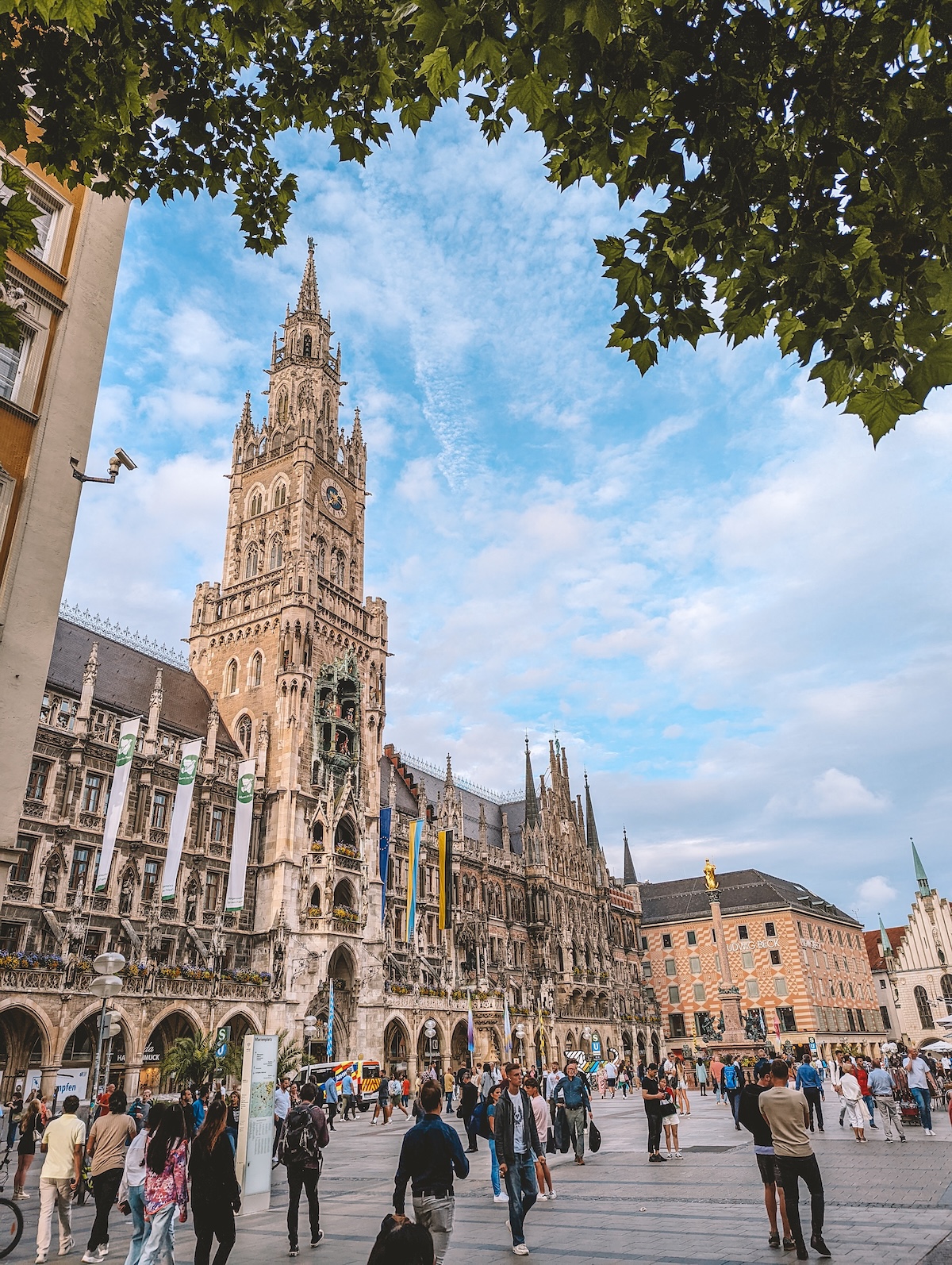
Whether you find yourself in Munich for Oktoberfest or are in town another time of year, there’s SO much to do and see in the city’s beautiful Old Town (Altstadt). From historic churches to an expansive palace complex to pretty squares, there’s a little bit of everything in this area.
I’ve visited Munich several times since moving to Berlin in 2019, and I always find something new and exciting to explore. This guide covers the top attractions in Munich’s Old Town, as well as lesser-known gems that locals adore, too!
I recommend spending at least one full day in the Old Town, but you can easily fill two days just visiting the historic buildings and taking in the sights. (After that, definitely explore the rest of Munich or take a day trip!)
Enjoy your time in Munich! -Claire
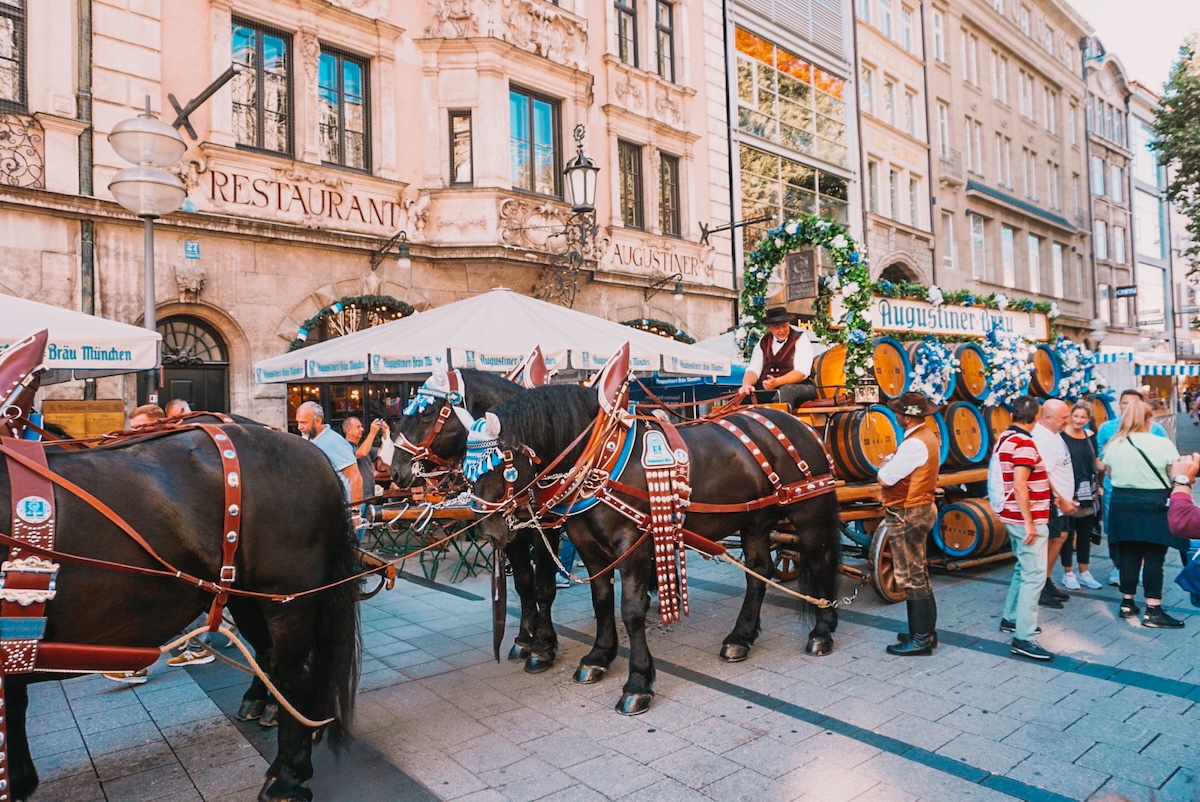
An Overview of the Top Attractions
What to See and Do
*Anything marked with a star is (in my humble opinion) an absolute must-see attraction.
- Karlsplatz (Stachus)
- St. Michael’s Church
- Frauenkirche (Cathedral of Our Lady)*
- Marienplatz*
- New Town Hall + Glockenspiel* — Book a guided tour of the Town Hall here
- “Alter Peter” (St. Peter’s Church)*
- Viktualienmarkt* — Book a gourmet food tour here
- Church of the Holy Spirit
- Hofbräuhaus* — Book a 1 hour guided tour (with 1 beer!) here
- National Theater
- Reseidenz* — Book your tickets + a 2.5 hour guided tour here
- Cuvilliés Theatre
- Theatine Church
- Hofgarten
Where to Stay
- Hotel MIO by AMANO ($$)
- Platzl Hotel – Superior ($$)
- Hotel Schlicker ($$)
- Hotel Torbräu ($$)
- DO & CO Hotel München ($$$)
Short on Time? Take a Walking Tour!
There are so many incredible places to visit in Munich’s Old Town, and if you’re short on time then a guided tour of some kind is likely the best option for you!
I’m partial to a classic guided walking tour of the Old Town, but you can also book a guided bike tour (very German!) or a beer and food tour (Bavarian food is excellent!). History buffs might prefer to book a WWII / Third Reich walking tour.
Looking for an itinerary so you don’t have to do the thinking?
My 3-day Munich itinerary covers the top things to do in the Old Town, plus my favorite attractions outside of the city center.
Claire’s Tip: Look for the “Wounds of Memory”
While exploring the Old Town, look out for the “Wunden der Erinnerung,” or Wounds of Memory, on the buildings. As the Old Town was rebuilt following World War II, the “scars” left by Allied bombs were kept on display both as a means of remembering those who lost their lives in WWII and also to showcase that the city remembers its Nazi history.
The Top Things to Do and See in the Old Town (in Walking Order!)
As Munich’s city center, it should come as no surprise that there’s a LOT to do in the Old Town.
This self-guided walking tour is *not* meant to take up a single day; I’ve simply shared the main attractions in the order that makes the most sense to visit them. Realistically you need a solid 2 to 3 days to see everything on this list, especially if you plan on going into every church and visiting all of the museums.
I wrote this guide assuming you’d be coming from the central train station (Hauptbahnhof) and walking from there to the Old Town.
Karlsplatz (Stachus)

This pretty square is officially called Karlsplatz and is named after Elector Karl Theodore. He made extensive renovations to this area in the late 1700s in an effort to create more room for the expanding populace.
Locals at the time didn’t like him, though, so they started calling this square “Stachus” after the Beim Stachus Pub that used to sit near the New House Gate (pictured above).
The New House Gate dates back to Medieval times and was one of Munich’s four main gates. Today, it’s just for decoration but it’s a reminder of the city’s unique history. Beyond the gate is a lovely fountain, called Fountain Boy.
Claire’s Tip: Karlsplatz is one of my favorite photo spots in the Old Town, but it’s also a major transportation hub so I recommend coming first thing in the morning to enjoy the fountain and scenic Medieval-esque backdrop before the crowds arrive.
Michaelskirche (St. Michael’s Church)
Opening hours: Monday and Friday 9:30am to 7pm, Tuesday – Thursday and Saturday 7:30am to 7pm, Sunday 7:30am to 9pm
Cost: Free
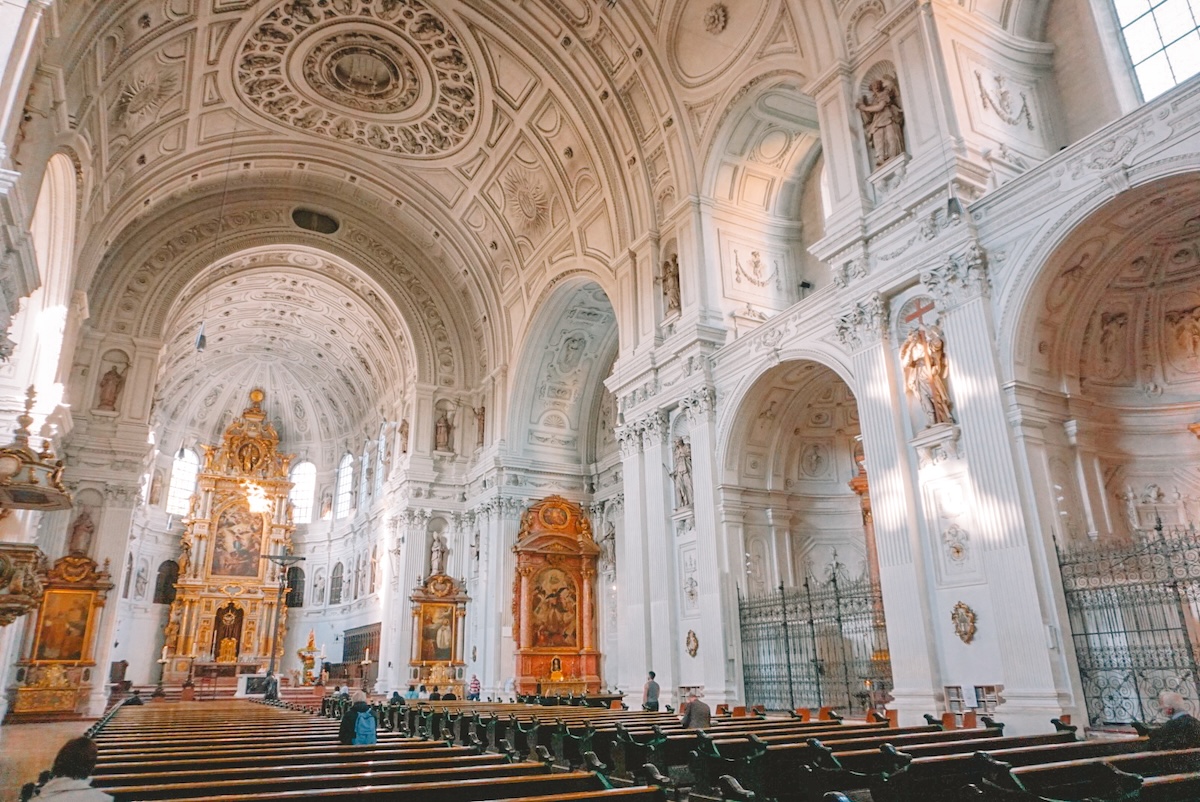
St. Michael’s is the largest Renaissance church north of the Alps. Like most buildings in the Old Town, it was severely damaged in WWII.
Much of its interior stucco work is missing, but I actually think it’s the prettiest of all the churches I’ve shared!
While in St. Michael’s be sure to visit the royal crypt. It’s the resting place of 40 Wittelsbach royals, including “Mad” King Ludwig II.
Frauenkirche (Cathedral of Our Lady)
Opening hours: 8am to 8pm daily
Cost: The church is free to enter, but climbing the towers costs 7.50 Euros
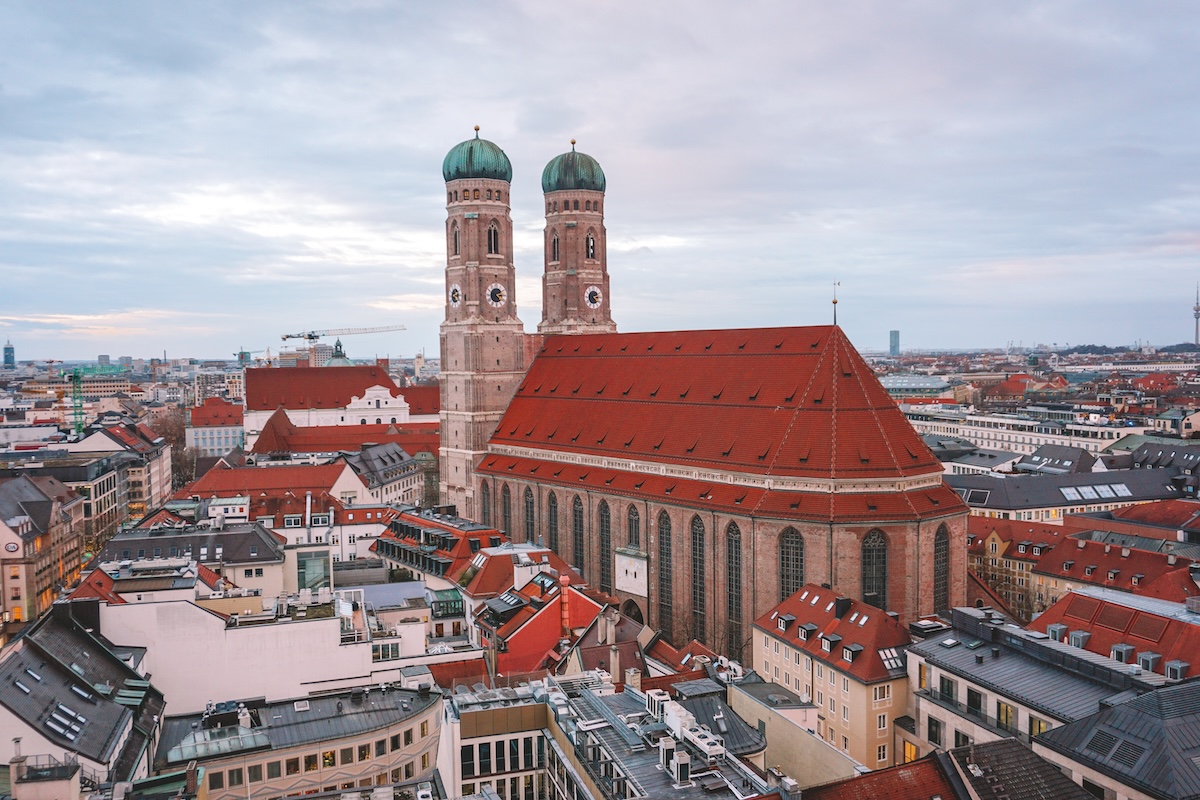
Munich’s soaring Frauenkirche is impossible to miss! The cathedral’s towers loom 325 feet overhead.
The massive towers were built to make a statement; as I mentioned above, Munich is one of the few Catholic cities in Germany. The Frauenkirche is a symbol of the people’s faith and the power of the Catholic church.
What I found fascinating about the Frauenkirche is that it was completed in 1488 after just 20 years of construction work. 20 years! That’s awfully quick for a cathedral of this size, wouldn’t you agree?
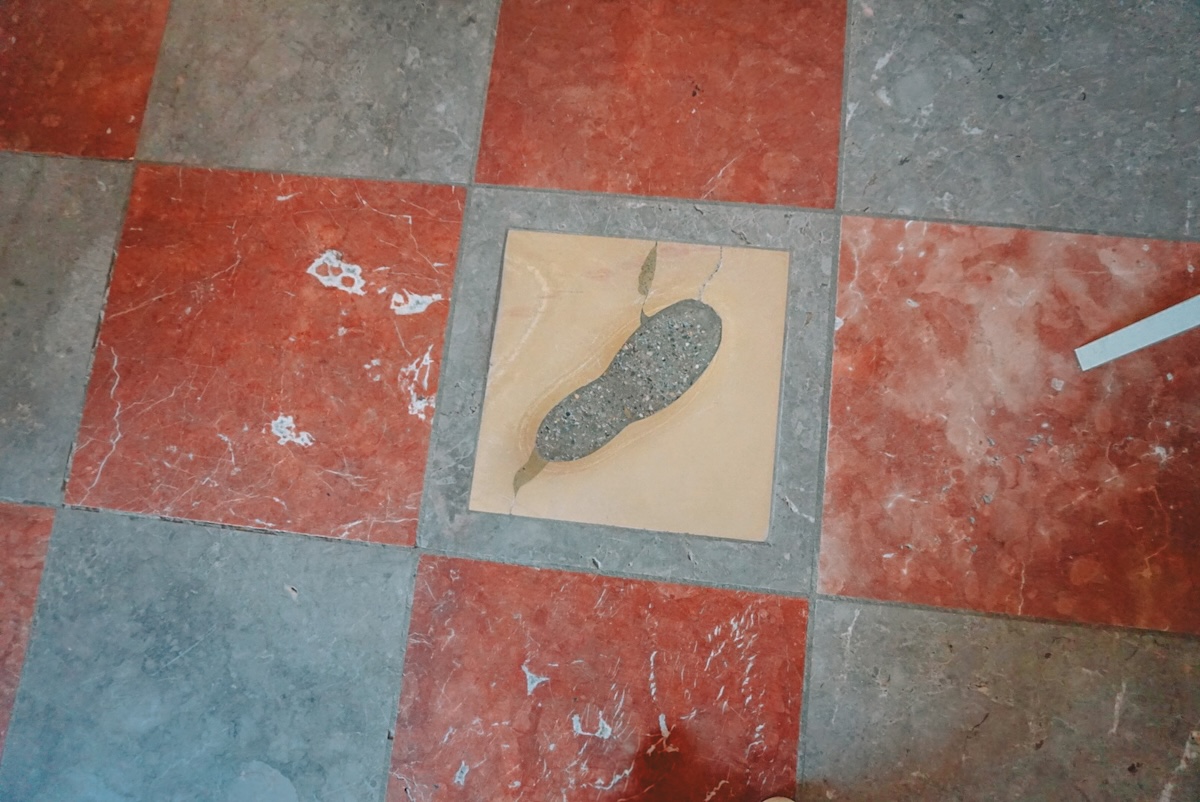
Legend has it that the cathedral’s architect made a deal with the devil in order to complete the project in the agreed 20-year time frame. The devil said he’d help fund the building project, but only if no windows were added to the cathedral.
Spoiler: the architect secretly added windows to the cathedral!
When the building was complete and the devil realized he’d been tricked, he stomped his foot on the floor in anger. To this very day, you can see the “Devil’s footprint” at the entrance of the Frauenkirche.
Claire’s Tip: The Frauenkirche was mostly destroyed in WWII. The towers miraculously survived, but the rest of the cathedral didn’t, which is why it looks so plain inside.
Marienplatz
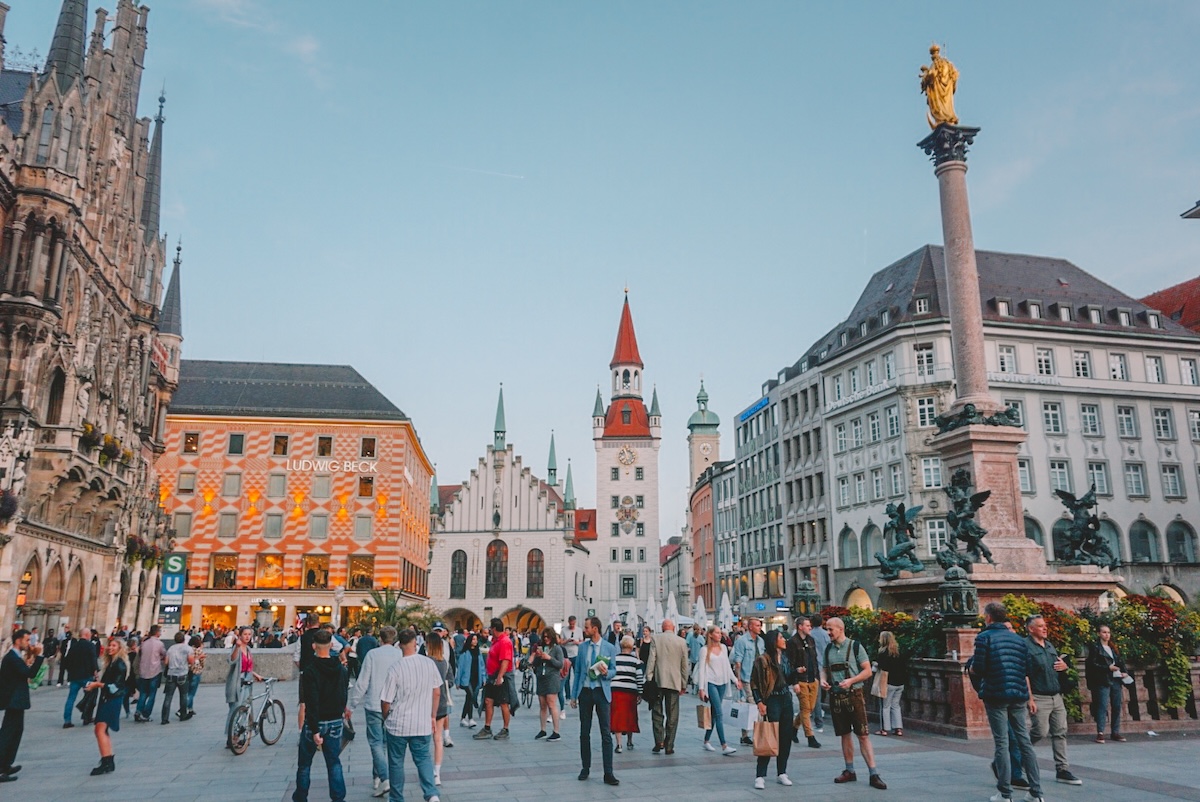
Arguably the prettiest square in Munich’s Old Town, Marienplatz (“Mary’s Square”) has historically always been the center of Munich.
The original marketplace founded by the Benedictine monks by order of Duke Henry the Lion was located at Marienplatz. The square got its name from the patron saint of Munich, Mary.
In the center of the square is the Mariensäule (Virgin Mary Column). It’s considered the official center of Munich. Fun fact: if you use Google Maps to determine the distance from Munich to another city, it will be measured starting at the Mariensäule!
On the edges of the Marienplatz, you’ll find the Neues Rathaus (New Town Hall) and the Altes Rathaus (Old Town Hall). They make a beautiful backdrop for this historic square!
Neues Rathaus (New Town Hall) + Glockenspiel
Opening hours: November – April 10am to 5pm; May – October 10am to 7pm
Cost: The observation deck costs 7 Euros (buy tickets at the tourist information office) and a guided tour of the Town Hall costs 25 Euros (book tickets here)
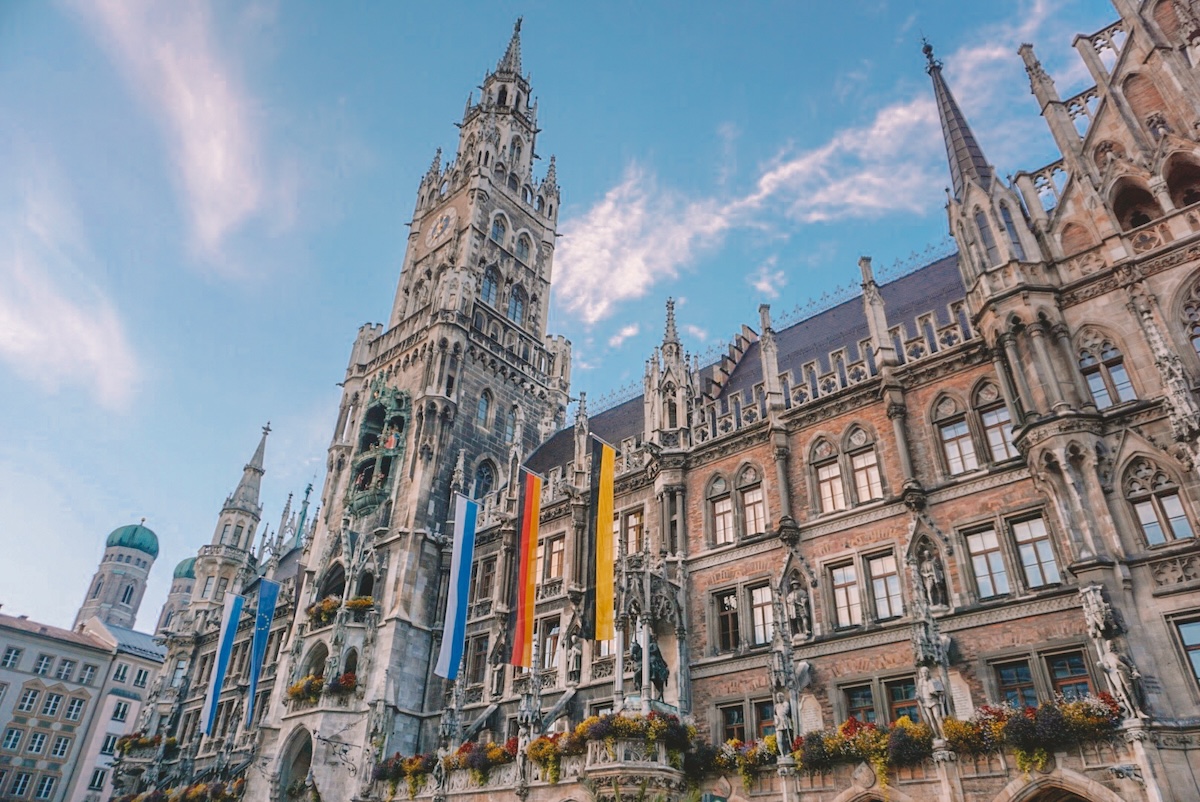
Munich’s Neues Rathaus is stunning! After 40 years of construction work, it was completed in 1905.
The Neues Rathaus is famous for its Glockenspiel. Each day at 11am, noon, and 5pm (in the summer), the Glockenspiel plays a 15-minute song.
As the song plays, the figures underneath the clock spring to life! They tell the story of a jousting tournament held in the 1560’s as part of the wedding celebrations for Bavarian Duke Wilhelm V and Renata of Lorraine.
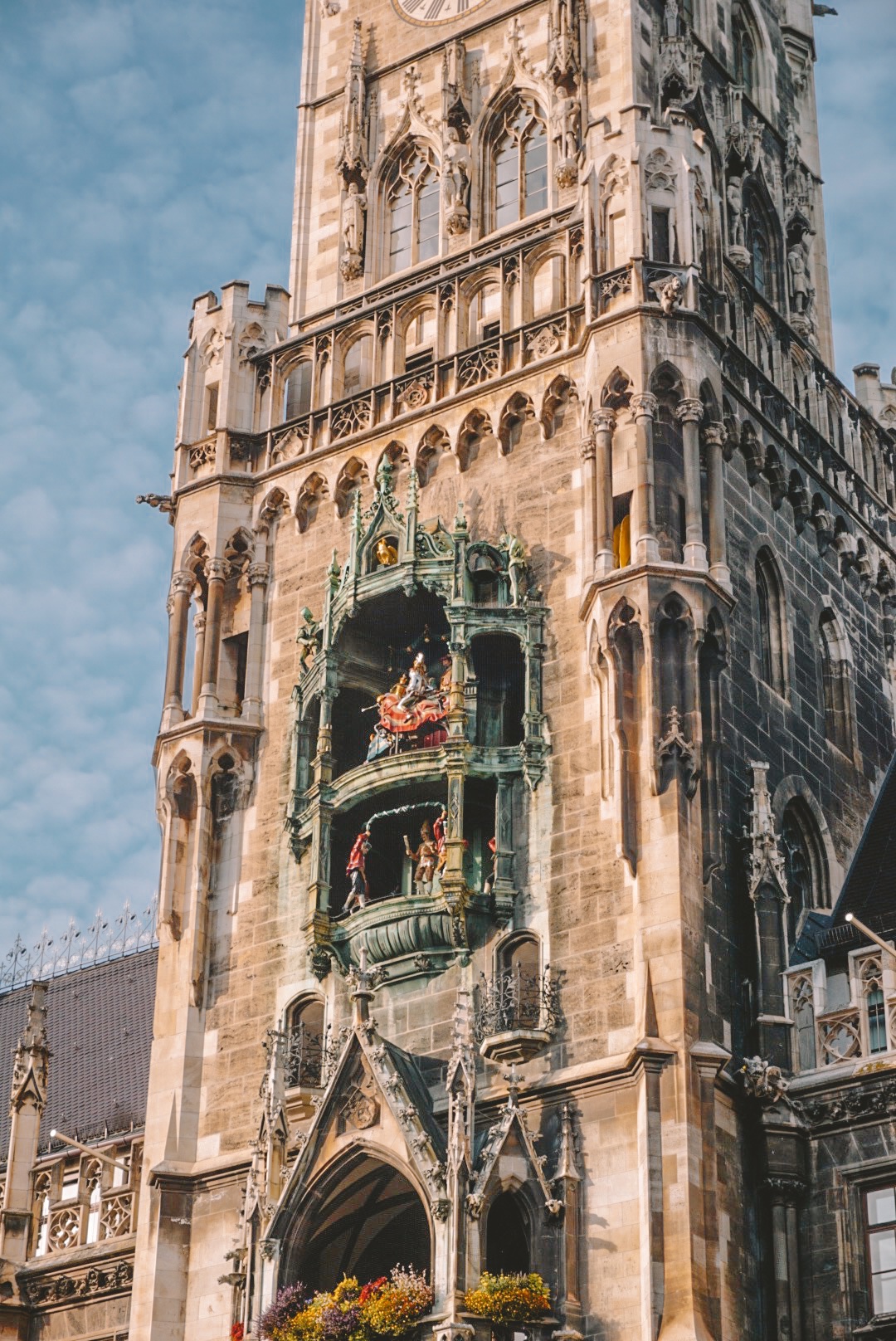
Additional figures below the jousting tournament show the dance of the coopers. They did a special dance to celebrate the end of the plague in 1517.
The inner courtyard of the Neues Rathaus is a pretty photo spot and has an open-air restaurant. When I visited Munich during Oktoberfest period, a lively oom-pah band was playing in the inner courtyard while people ate. It was so fun and festive!
Claire’s Tip: For an unparalleled view of the city, you can pay a couple Euros to go up the bell tower of the Neues Rathaus. Unfortunately, the town hall building itself won’t be in the photo since you’ll be standing on it, but the rest of Munich looks gorgeous!
“Alter Peter” (St. Peter’s Church)
Opening hours: April – October 9am to 7:30pm daily; November – March 9am to 6:30pm (open until 7:30pm on Saturday and Sunday)
Cost: Church itself is free, but climbing the tower costs 5 Euros
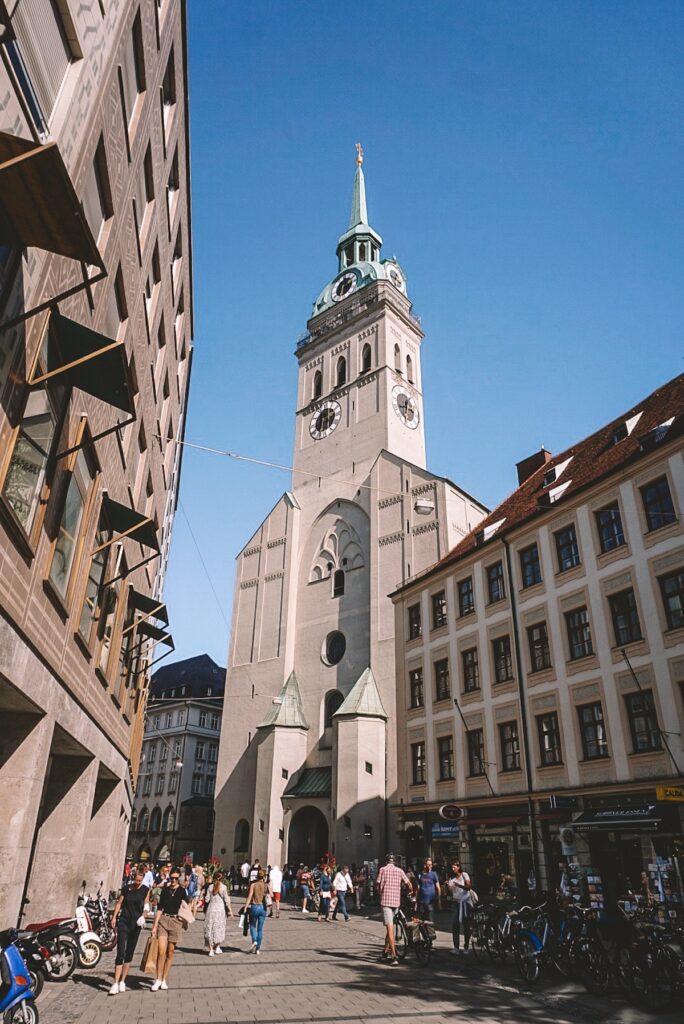
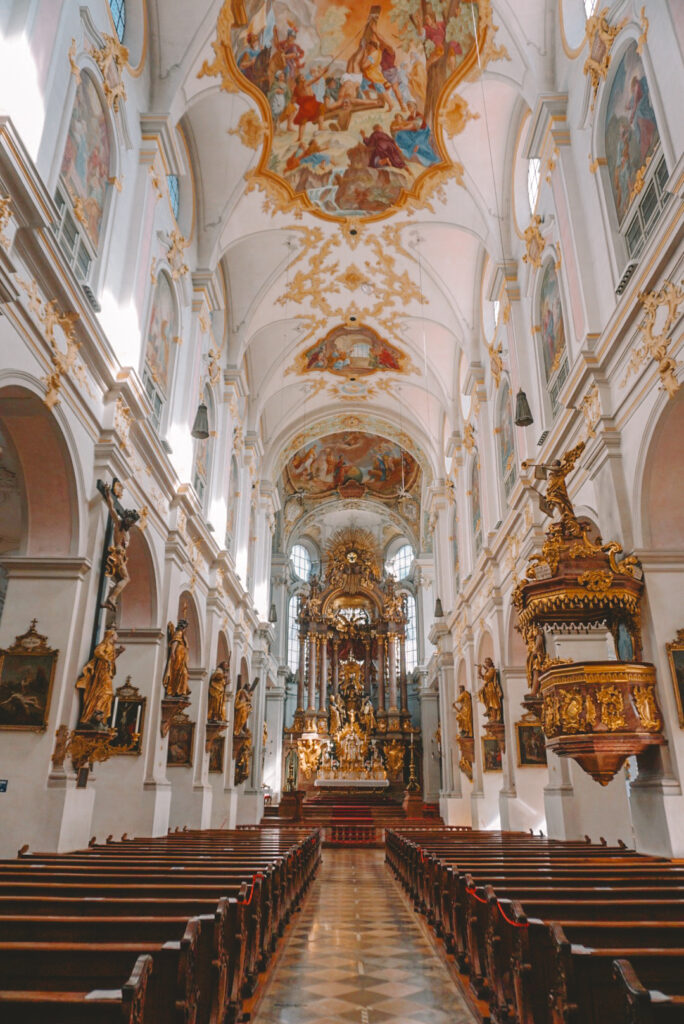
Given that Peter was Jesus’ first disciple, it’s fitting that the oldest church in Munich be named after him. St. Peter’s Church has been damaged and rebuilt many times since it was founded (it was actually founded before Munich even became a city, it’s so old!).
Today, you can climb the 306 steps up the church’s bell tower for another beautiful view of the city.
If you don’t want to waste money on a pretty view, the church itself is still worth going into. As you can see in the photo above, St. Peter’s is incredible. It houses the remains of Saint Munditia, who is the patron saint of single and unmarried women.
Claire’s Tip: The benefit of climbing this tower versus the town hall’s tower is that you’ll actually get the town hall in the photo! However, it’s best to get to the church early since there’s always a long line of people waiting to go up the tower.
Asamkirche (St. Johann Nepomuk Church)
Opening hours: 9am to 6pm daily, but on Friday it’s open 1pm to 6pm
Cost: Free
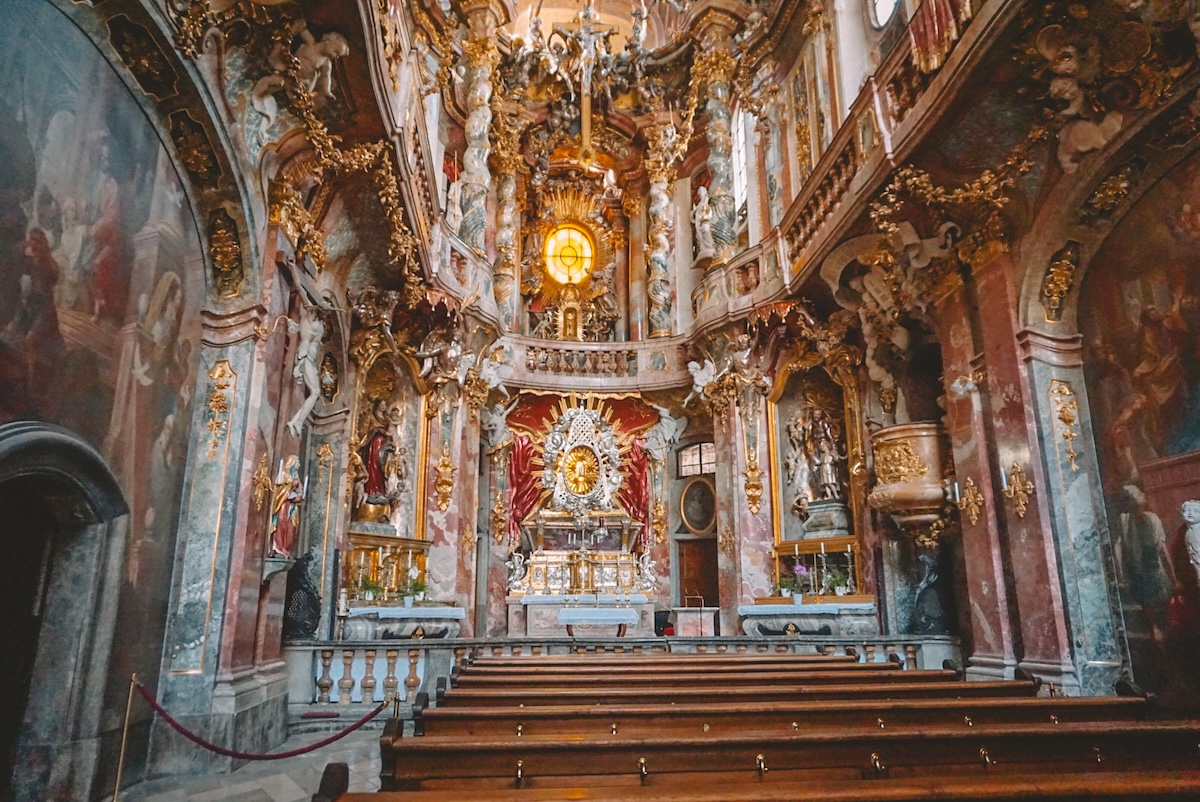
I won’t lie, I couldn’t decide whether I thought the Asamkirche was gorgeous or hideous.
Its official title is the Saint Johann Nepomuk Church, but no one calls it that. It got the name “Asamkirche” because it was built by the Asam brothers in the 1740’s.
The church is a mere 30 feet wide but is decked out in opulent Baroque fixtures and frescoes. The Asam brothers were a sought-after pair of artists and architects who built the Asamkirche as a showroom church to advertise their skills.
Claire’s Tip: The Asam brothers lived next door to the church and supposedly could see the high altar from their bedroom windows!
Viktualienmarkt (Victuals Market)
Opening hours: 8am to 8pm Monday – Saturday (note that individual stalls operate on their own schedule and that the square itself can be accessed any time of day)
Cost: Free (Or, book a guided food tour of the Viktualienmarkt to learn more about its unique history in the best way possible — by eating your way through it!)
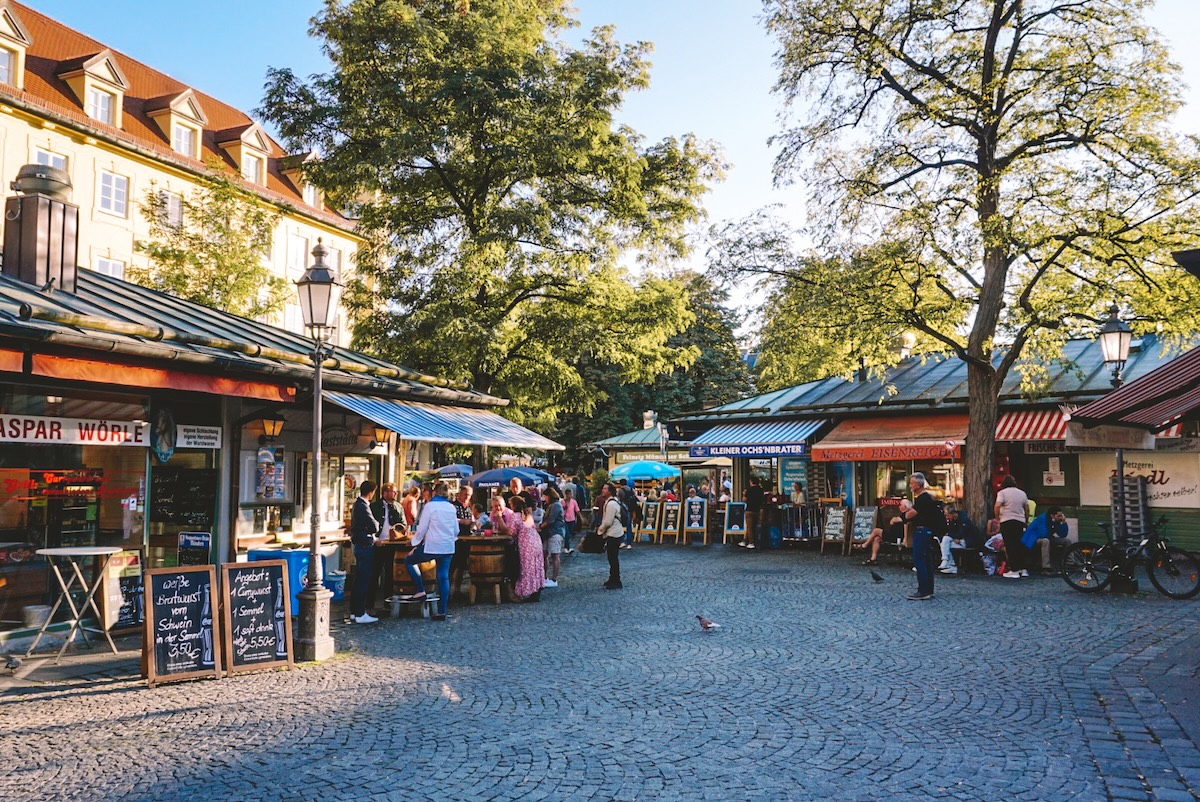
What began as a small farmers market in the 1700’s is now Munich’s main market. There are lots of stalls selling local meats, cheeses, and all the fresh produce you could possibly need.
In the center of the Viktualienmarkt is a beer garden, which is packed during the warmer months. And of course, you can’t miss the giant Maypole in the center of the market that’s stood there since 1962!
If you’re traveling on a budget or simply don’t feel like eating in a restaurant, come to the Viktualienmarkt for picnic supplies! There are also plenty of stalls selling pre-made meals like soups, bratwurst, and so on.
Heilig-Geist-Kiche (Church of the Holy Spirit)
Opening hours: 9am to 8pm Monday through Friday, 8:30am to 8pm Saturdays and Sundays
Cost: Free
It’s impossible to walk past the stunning Heilig-Geist-Kirche on the edge of the Viktualienmarkt. It’s one of the oldest churches in Munich’s historic center, having been a hospital parish church since 1271.
The original building was destroyed in a citywide fire in the 1320s and rebuilt in the Gothic style. The Asam brothers (who built the elaborate Asamkirche mentioned earlier in this guide!) later transformed it into the Baroque masterpiece you see today.
Hofbräuhaus
Opening hours: 11am to midnight daily (kitchen closes at 10pm; last call for drinks 11:30pm)
Reservation required? If you plan on eating dinner here, I suggest reserving a table just to play it safe (especially during Oktoberfest!). Otherwise you should be fine to walk in and just find a seat. Or, book a guided tour of the Hofbräuhaus, which includes one beer.
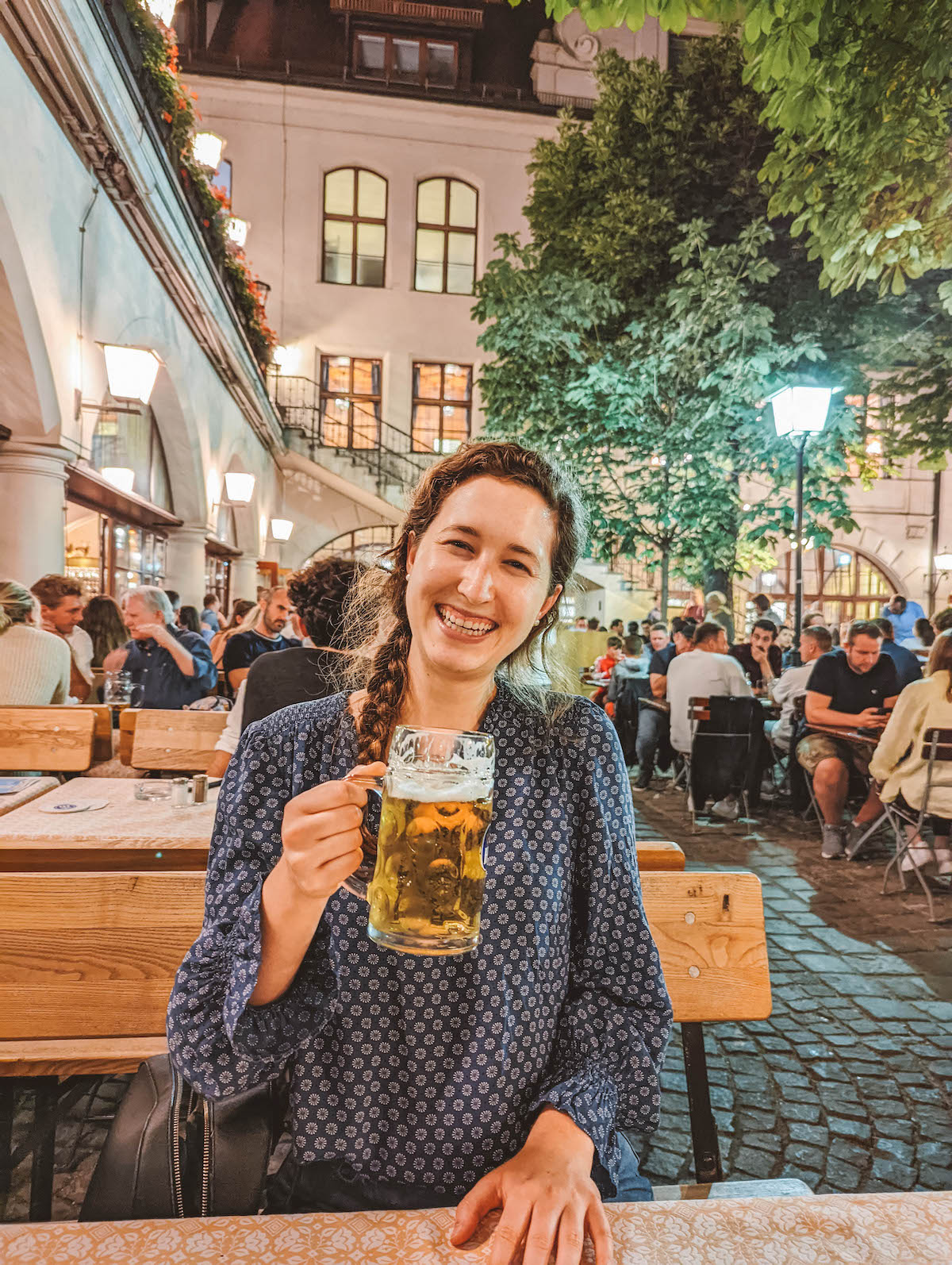
There are six main breweries in Munich, but the Hofbräuhaus (“Royal Court Brew House”) is the best known. When the beer hall opened in 1607, only the royal family and their guests were let inside.
In the 1820’s, King Ludwig I opened the Hofbräuhaus to the public as part of his wedding celebrations. Each year after that, Ludwig continued to host anniversary celebrations for him and his wife and is the origin of Munich’s world-renowned Oktoberfest.
However, the Hofbräuhaus has a dark history as well. It was here that Hitler and his associates founded the Nazi party in 1920.
Although more tourists than locals can be found at the Hofbräuhaus in Munich’s Old Town, it’s still a fun place to visit and sip on a liter of beer (yes, I said liter!). The food here is pretty good, and the lively atmosphere makes for a memorable evening.
Bayerische Staatsoper (Bavarian State Opera House / National Theater)
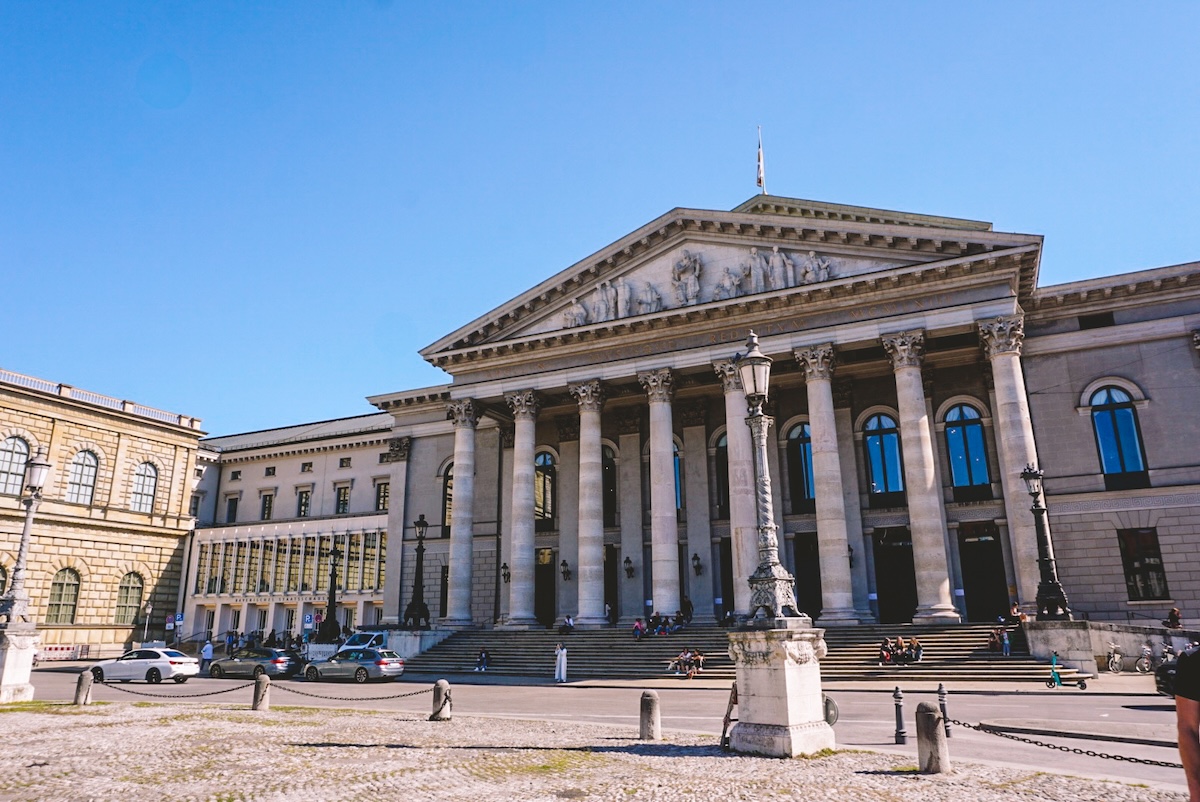
If you’ll be in Munich for more than a few nights, it’s well worth booking tickets to see a performance at the State Opera House. It’s home to the Bavarian State Opera, Bavarian State Ballet, and Bavarian State Orchestra, and there are performances almost every day.
The imposing Neoclassical theater opened its doors in 1818, although the history of the National Theater itself stretches back nearly 350 years. This is considered to be one of the finest opera houses in the world, so it’s a must for any theater lovers traveling to Munich!
Claire’s Tip: Guided tours are also available in both English and German for just 10 Euros if a performance isn’t in the cards this visit.
Residenz (Former Royal Palace)
Opening hours: From April 1 – October 19 the Residenz is open daily from 9 am to 6 pm. From October 20 – March 31, it’s open daily from 10 am to 5 pm.
Cost: 10 Euros for just the Residenz OR the treasurey, or 15 Euros for a combined ticket to see both (my suggestion!)
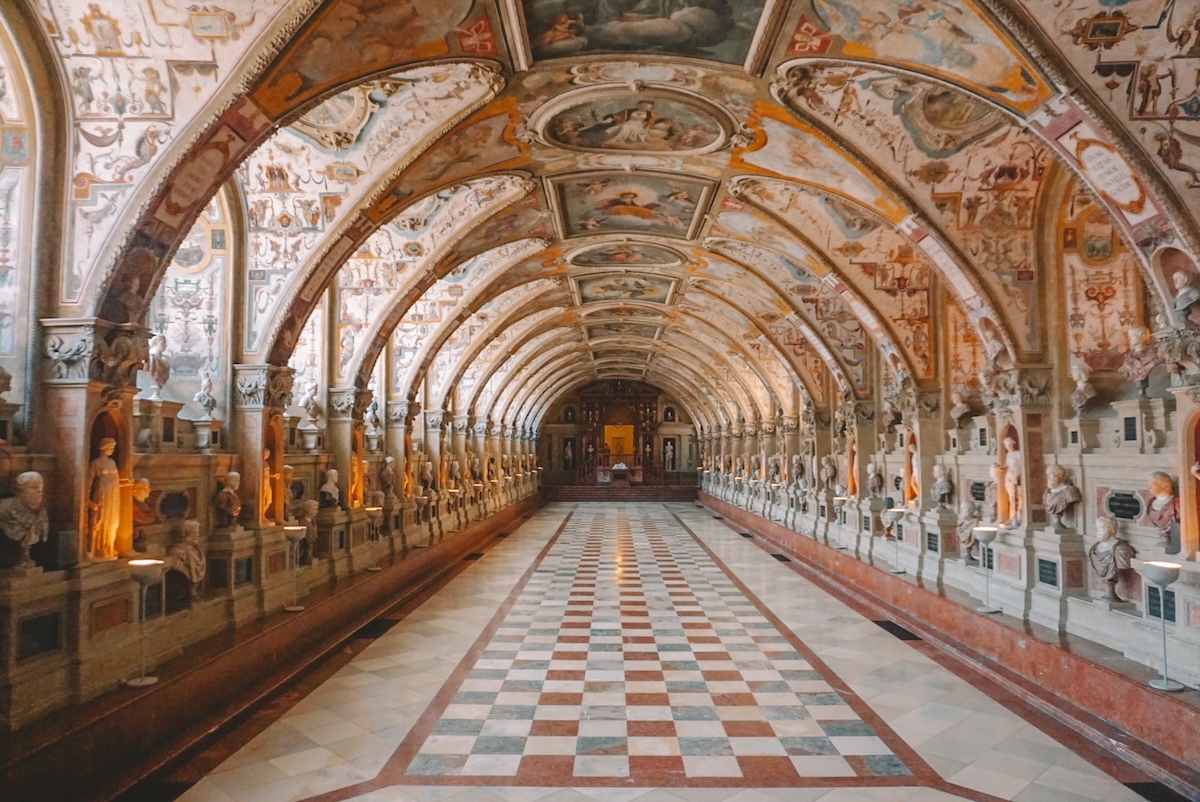
The Munich Residence (Residenz in German) was the seat of government and home to the royal family from 1508 to 1918.
Over the centuries, each new ruler added his own suite of rooms and personal touches to the palace, which explains how it became the sprawling complex it is today.
A tour of the Munich Residence includes access to over 100 (!!) rooms of the palace — which is a mere sampling of the palace as a whole.
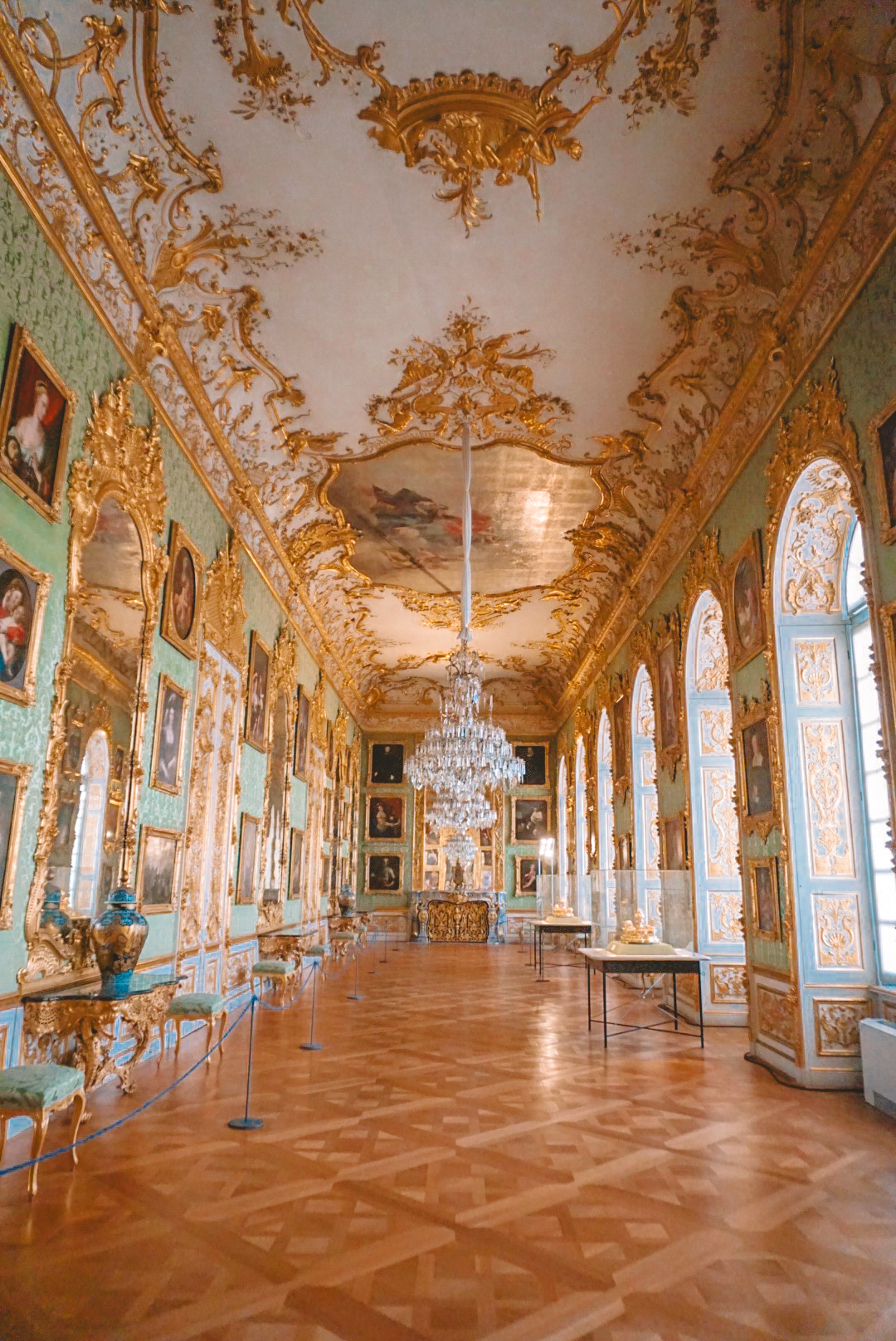
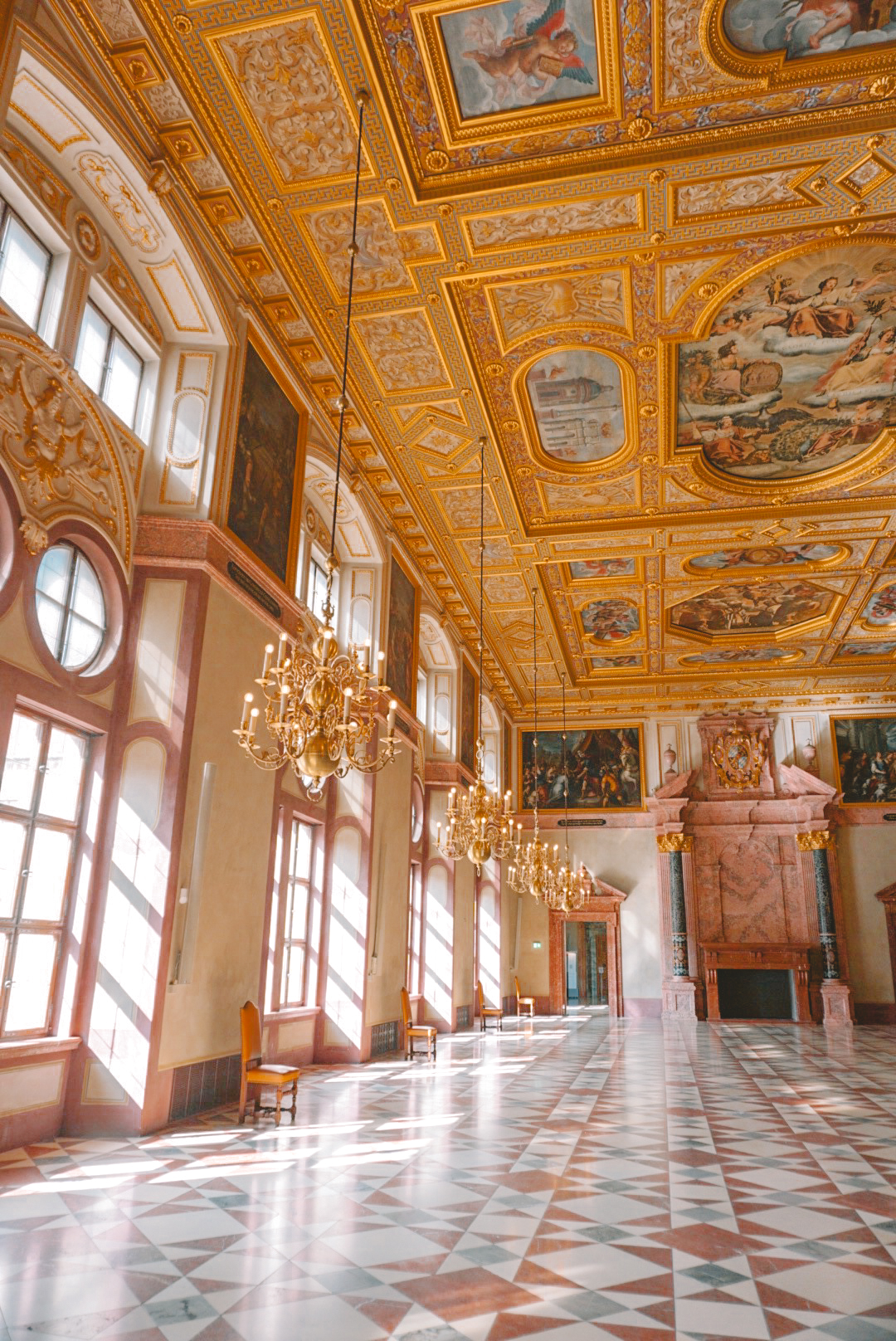
My personal favorite parts of the Residence were:
- The Antiquarium: A 66-meter long Renaissance banquet hall with ceiling frescoes and antique sculptures lining the walls.
- The Court Chapel: Built in the 17th century for the court and royal family to worship.
- The Green Gallery: A stunning picture and mirror gallery with 70 pieces of art on display.
Claire’s Tip: When visiting the Residence, give yourself at least 3 to 4 hours to see everything! The audio guide is very detailed, and there’s a lot to look at.
Cuvilliés Theatre
Opening hours: Depends on the month! Check the website to see when it will be open during your visit.
Cost: 5 Euros (or pay 20 Euros for a combination ticket to see the Residence, treasury, and theater – that’s what I did!)
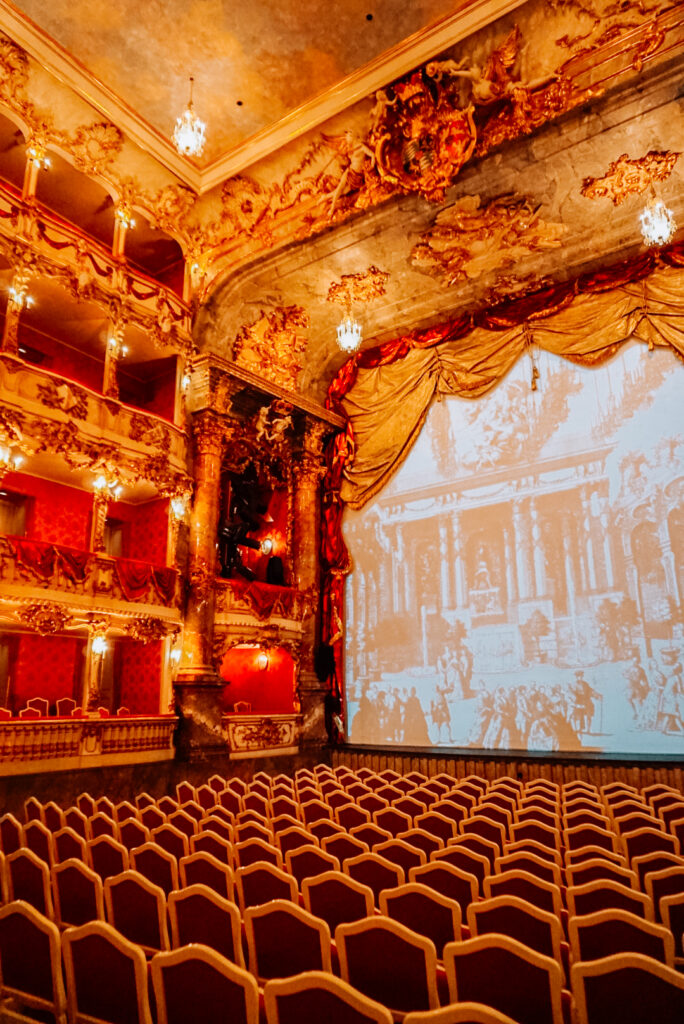
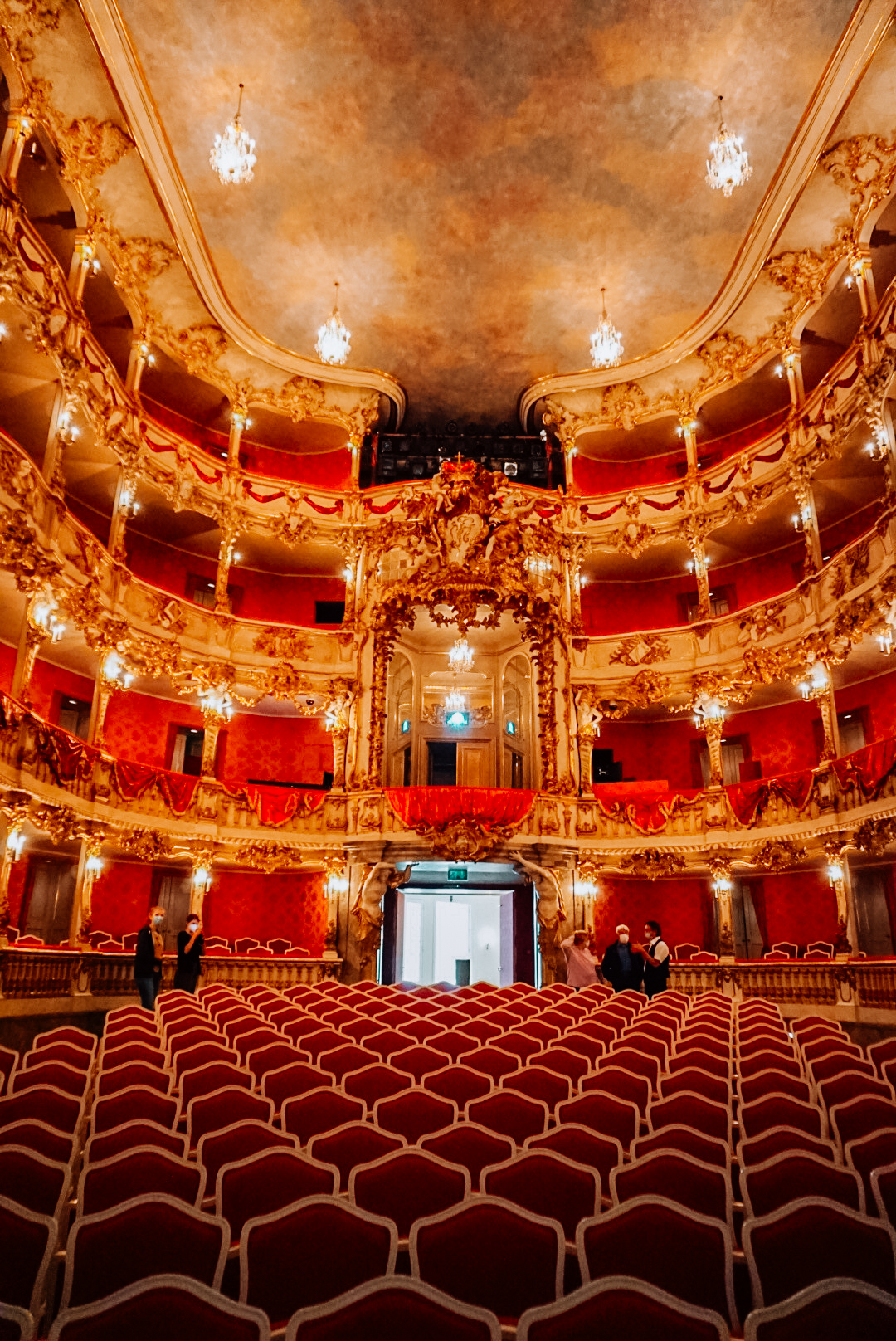
Located in the same complex as the Munich Residenz, the jaw-droppingly beautiful Cuvilliés Theatre was built by François Cuvilliés the Elder 1751 to 1755. It was built as the “new opera house” for Elector Maximillian Joseph III.
The building housing the original Rococo theatre was destroyed by an Allied bombing raid in 1944. Luckily for us, all of the original woodwork was moved to a safe location beforehand so what you see in the theatre today is mostly original.
Theatinerkirche (Theatine Church)
Opening hours: Varies (the church is open daily, but sometimes it’s closed for seemingly no reason)
Cost: Free
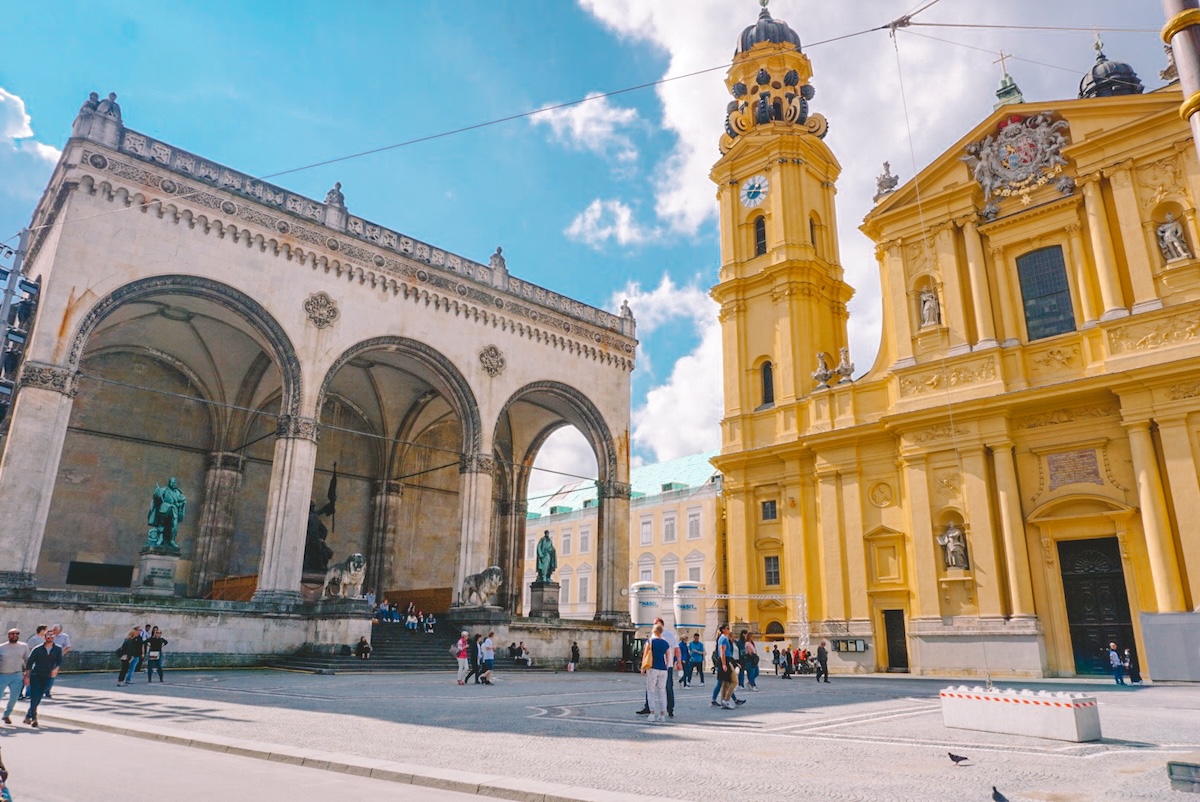
Upon entering the picturesque Odeonsplatz on the outskirts of the Old Town, it’s impossible to miss the brightly colored mustard facade of the Theatinerkirche. The church was built by Elector Ferdinand in honor of Saint Cajetan of Theatine.
Ferdinand and his wife weren’t able to produce a male heir for 10 years. Desperate for a son, he promised to build a church in honor of Saint Cajetan of Theatine if the saint blessed them with a child.
The church opened its doors in 1674, but it wasn’t fully finished until 1765. The interior was built in the Italian high-Baroque style, but the mustard facade is in the Rococo style.
Hofgarten (Court Garden)
Opening hours: Open 24/7
Cost: Free
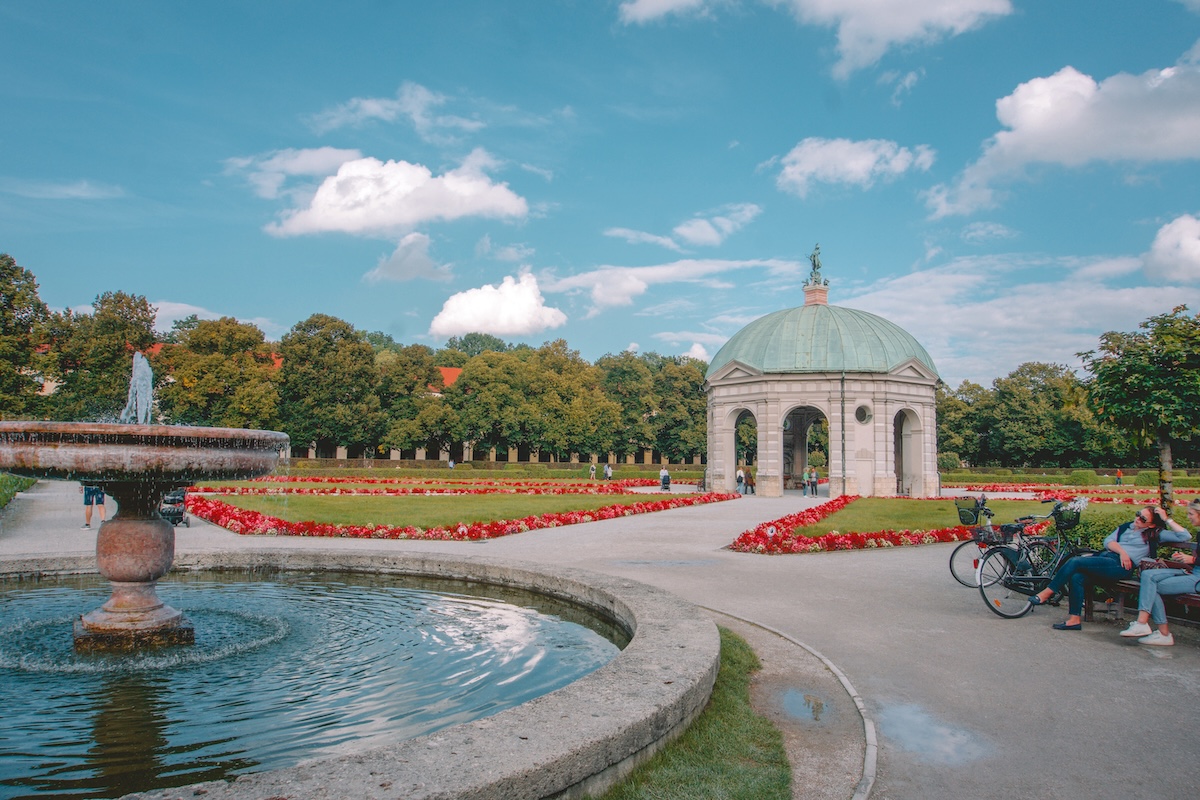
The Hofgarten (Court Garden) was formerly part of the Munich Residenz. The garden was built in the 17th century in the style of Italian Renaissance gardens.
It’s the perfect spot to relax on a sunny day, as it’s still within the boundaries of the Old Town but is far enough from the city center that not as many come here.
Seasonal Activity: Visit the Christmas Markets
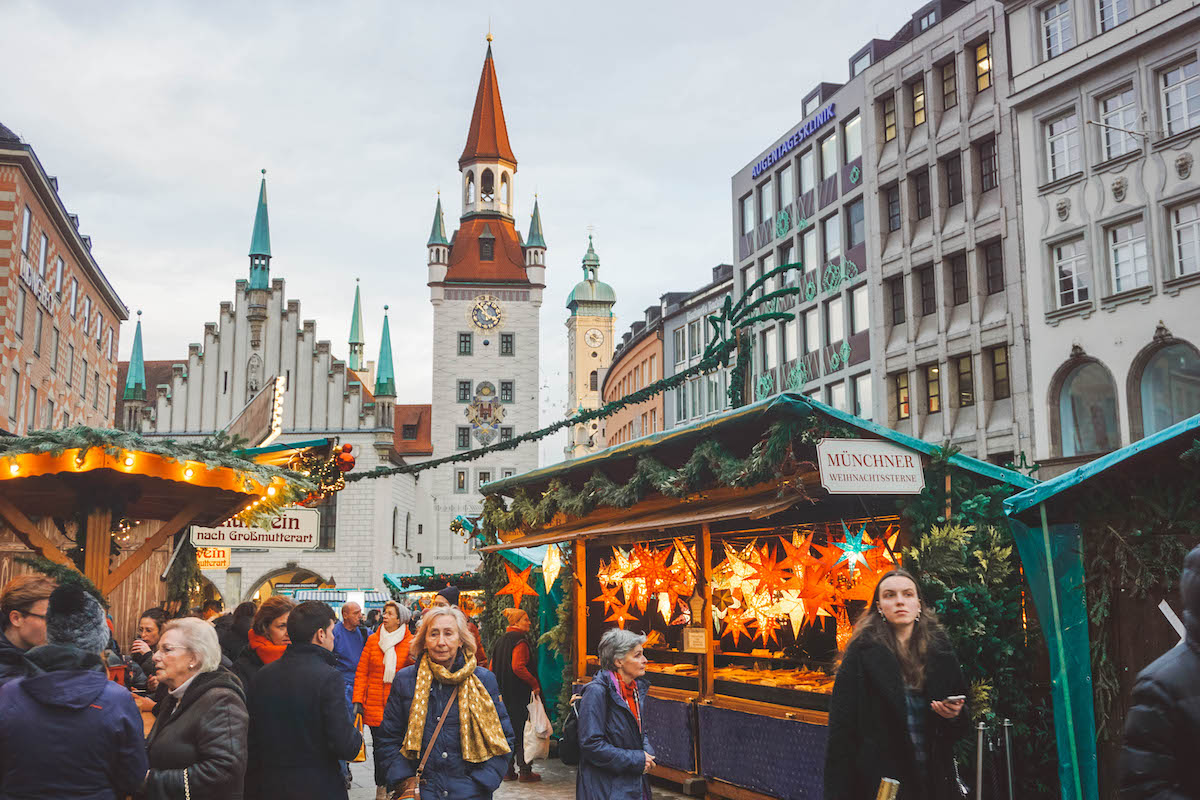
Munich is best known for its Oktoberfest celebrations, but it also happens to have some of the best Christmas markets in Germany.
The Christkindlmarkt at Marienplatz is a traditional Christmas market in the heart of the Old Town — and also my personal favorite in the city!
Around the corner from the Christkindlmarkt is the Kripperlmarkt, or nativity market. This special Christmas market sells only figurines and set pieces for nativities of all styles and sizes.
Claire’s Tip: I have a full guide to Munich’s many Christmas markets. There are quite a few scattered throughout the city!
Map of the Old Town’s Attractions
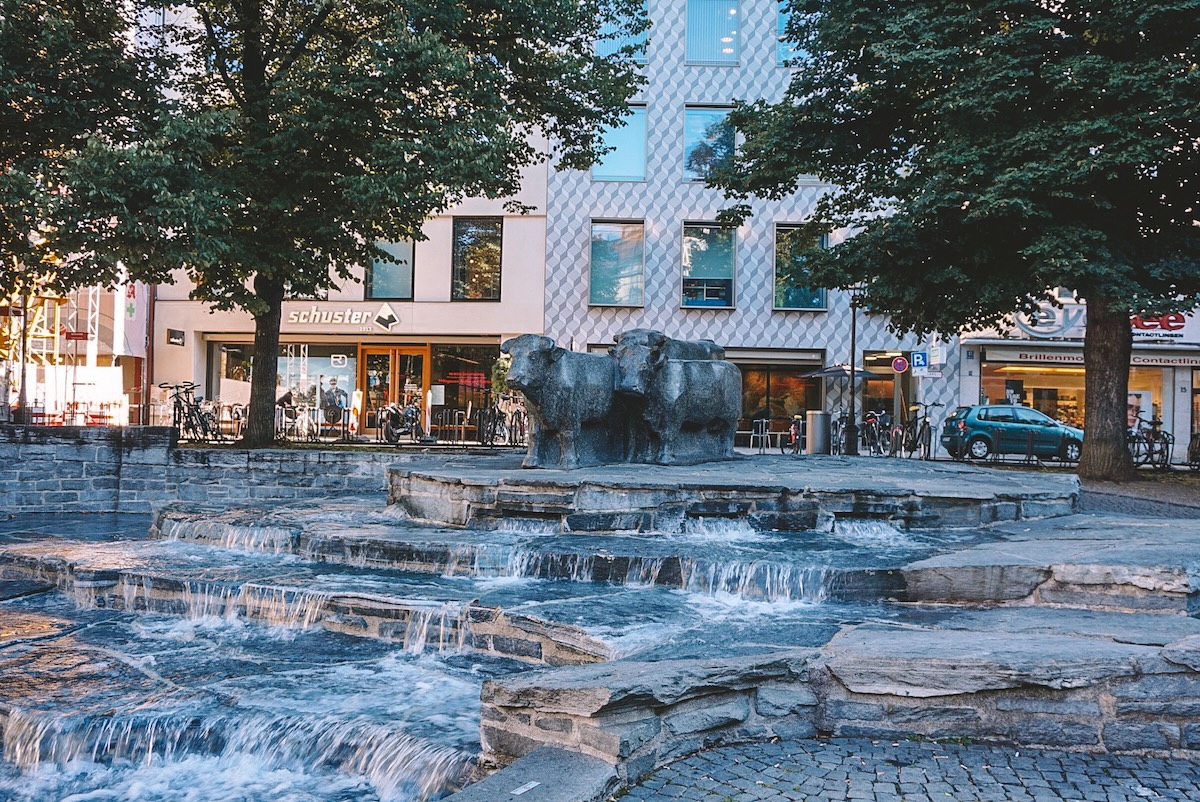
Frequently Asked Questions
The very abbreviated version of the city center’s long and fascinating history is as follows:
Munich was officially founded in 1158 by the Bavarian Duke Henry the Lion. The name “Munich” comes from the German word for “monks,” which is in reference to the original settlers of the area — a group of Benedictine monks that are thought to have lived on the land as far back as 750 CE.
The Old Town was reduced to rubble during World War II and was rebuilt leading up to the 1972 Munich Olympics. (The city did an excellent job restoring the buildings!)
If you don’t plan on visiting any museums and are okay being on your feet for a longer period of time, you can tour the Old Town in one day.
However, you’ll need at least two full days if you plan on touring the Residenz and / or going into one of the museums.
Yes! Many of the shopping streets are pedestrian-only, and it’s easy to get everywhere on foot.
The area around the Rindermarkt has some good stores, as do Maximilianstraße and Sendlinger Straße.
Is Munich’s Old Town Worth Visiting? Final Thoughts
Now that you know what all there is to do in Munich’s Old Town, I hope you feel inspired to visit. It’s one of the best Old Towns in Germany and has lots to see and do.
If you have any questions about visiting Munich in general or the Old Town in particular, drop me a comment down below so I can help you out!
Don’t forget to follow me on Instagram to keep up with my daily adventures in Berlin and beyond!

Comments & Reviews
Fantastic article on Munichs old town. Thank you!
One of the best travel blog posts I’ve ever read!